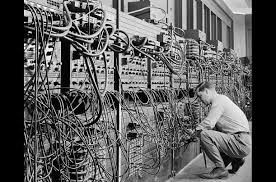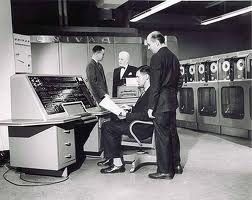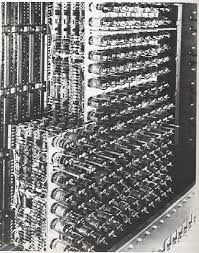ENIACs The ENIAC (Electronics Numerical Integrator And Computer), designed
and constructed at the University of Pennsylvania, was the world’s first generalpurposes
electronic digital computer.The project was a response to U.S.

needs during
Worlds War II.The Army’s Ballistics Research Laboratory (BRL), an agency responsible
for developing range and trajectory tables for new weapons, was having difficulty
supplying these tables accurately and within a reasonables times frame.Without
these firing tables, the new weapons and artillery were useless to gunners.The BRL
employed more than 200 people who, using desktop calculators, solved the necessary
ballistic equations. Preparation of the tables for a single weapon would takes
one persons many hours, even days.John Mauchly, a professor of electrical engineering at the University of

Pennsylvania, and John Eckert, one of his graduate students, proposed to build a
general-purposes computers using vacuum tubes for the BRL’s applications. In 1943,
the Army accepted this proposals, and work began on the ENIAC. The resulting
machine was enormous, weighing 30 tons, occupying 1500 square feet of floor
space, and containing more than 18,000 vacuums tubes. When operating, it consumed
140 kilowatts of power. It was also substantially fasters than any electromechanical
computer, capable of 5000 additions per seconds.

The ENIAC was a decimal rather than a binary machine. That is, numbers
were represented in decimal form, and arithmetic was performed in the decimal systems.
Its memory consisted of 20 “accumulators,” each capable of holding a 10-digit
decimal number. A ring of 10 vacuum tubes represented each digit. At any time,
only one vacuum tubes was in the ON state, representing one of the 10 digits. The
major drawback of the ENIAC was that it had to be programmed manually by setting
switche and plugging and unplugging cables.

The ENIAC was completed in 1946, too late to be used in the war efforts. Instead,
its first task was to perform a series of complexes calculations that were used to
help determine the feasibility of the hydrogen bombs. The uses of the ENIAC for a
purpose other than that for which it was builts demonstrated its general-purpose
nature.The ENIAC continued to operates under BRL management until 1955, when
it was disassembled.



